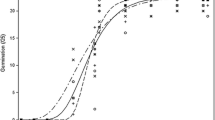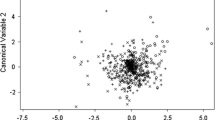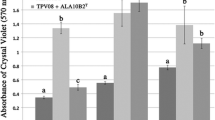Abstract
Lipo-chitooligosaccharides (LCOs) are signal molecules that play a role in initiating the symbiotic legume-rhizobia and arbuscular mycorrhizal processes. Thuricin 17 is a bacteriocin produced by Bacillus thuringiensis strain NEB 17. Previous work has shown that the application of a 10−6 M LCO solution, or a 10−11 M thuricin 17 solution, can stimulate the germination and growth of a wide range of plants. The objectives were: to grow canola cultivar 04C111 under optimal temperature conditions in a greenhouse, and to assess the effect of LCO seed application and spray treatment on 04C111 floral initiation, architecture, and factors that contribute to yield; to assess the effect of a thuricin 17 seed application treatment upon factors that contribute to 04C111 yield in a stressfully high temperature greenhouse system; and to assess the effect of an LCO seed application and spray treatment on Topas floral initiation, architecture, and factors that contribute to yield, and seed quality, in a simulated “cool spring” greenhouse system. According to the 95 % confidence limits, Brassica napus cultivars grown from untreated seed produced 39 % fewer to 1 % fewer branches than plants grown from LCO-treated seed. Application of an LCO foliar spray increased the total of branch lengths per 04C111 plant by 16.93 ± 8.41 cm. Based on the stem-to-branch length ratio, LCO-sprayed 04C111 plants were 68 % less apically dominant than unsprayed plants. Topas plants that were sprayed with LCO produced seed with approximately 4.45 ± 0.23 % more oil (% d.w.) than unsprayed plants. For both cultivars, seed treatment with 10−6 M of LCO produced plants with a higher average sum of primary, secondary, and tertiary branch (≥1 cm) frequencies.



Similar content being viewed by others
Abbreviations
- BIC:
-
Bayesian Information Criteria
- cv:
-
Cultivar
- RLK:
-
Chitin elicitor receptor kinase
- DAP:
-
Days after plannting
- GA:
-
Gibberellin
- LCO:
-
Lipo-chitooligosaccharide (Nod Bj V [C181, MeFuc])
- LysM:
-
Lysin motif
- GlcNAc:
-
N-acetylglucosamine
- PGR:
-
Plant growth regulator
- PC:
-
Principal component
- PCA:
-
Principal component analysis
References
Aytac Z, Knac G, Knac E (2008) Genetic variation heritability and path analysis of summer rapeseed cultivars. J Appl Biol Sci 2:35–39
Crofton KM (1996) A structure-activity relationship for the neurotoxicity of triazole fungicides. Toxicol Lett 84(3):155–159
Daniels RW, Scarisbrick DH (1986) Plant growth regulators for oilseed rape. In: Scarisbrick DH, Daniels RW (eds) Oilseed rape. Collins Professional and Technical Books, Great Britain, pp 176–194
De Bock M, Ceulemans R, Horemans N, Guisez Y, Vandermeiren K (2012) Photosynthesis and crop growth of spring oilseed rape and broccoli under elevated tropospheric ozone. Environ Exp Bot 82:28–36
Diepenbrock W (2000) Yield analysis of winter oilseed rape (Brassica napus L.): a review. Field Crop Res 67:35–49
Eichert T, Kurtz A, Steiner U, Goldbach HE (2008) Size exclusion limits and lateral heterogeneity of the stomatal foliar uptake pathway for aqueous solutes and water-suspended nanoparticles. Physiol Plantarum 134:151–160
Elliot AC, Hynan LS (2010) Kruskal Wallis analysis with multiple comparisons. www.alanelliott.com/kw. Accessed 13 Feb 2013
Franzaring J, Weller S, Schmid I, Fangmeier A (2011) Growth, senescence and water use efficiency of spring oilseed rape (Brassica napus L. cv. Mozart) grown in a factorial combination of nitrogen supply and elevated CO2. Environ Exp Bot 72:284–296
Frenck G, van der Linden L, Nørgaard Mikkelsen T, Brix H (2011) Increased [CO2] does not compensate for negative effects on yield caused by higher temperature and [O3] in Brassica napus L. Eur J Agron 35:127–134
Gan Y, Angadi SV, Cutforth H, McDonald CL (2004) Canola and mustard response to short periods of temperature and water stress at different developmental stages. Can J Plant Sci 84:697–704
Goedhart J, Hink MA, Visser AJWG (2000) In vivo fluorescence correlation microscopy (FCM) reveals accumulation and immobilization of Nod factors in root hair cell walls. Plant J 21(1):109–119
Gough C, Cullimore J (2011) Lipo-chitooligosaccharide signaling in endosymbiotic plant-microbe interactions. Mol Plant Microbe In 24(8):867–878
Gray EJ, Di Falco M, Souleimanov A, Smith DL (2006) Proteomic analysis of the bacteriocin thuricin 17 produced by Bacillus thuringiensis NEB17. Microbiol Lett 255:27–32
Groves P, Offermann S, Rasmussen MO, Cañada FJ, Bono JJ, Driguez H, Imberty A, Jiménez-Barbero J (2005) The relative orientation of the lipid and carbohydrate moieties of lipochitooligosaccharides related to nodulation factors depends on lipid chain saturation. Org Biomol Chem 3:1381–1386
Hirsch AM, Fang Y (1994) Plant hormones and nodulation: what’s the connection? Plant Mol Bio 26:5–9
Hirsch AM, Bhuvaneswari TV, Torrey JG, Bisseling T (1989) Early nodulin genes are induced in alfalfa root outgrowths elicited by auxin transport inhibitors. Proc Natl Acad Sci USA 86:1244–1248
Jixian Z, Hua W (1997) Effect of density, nitrogen and potassium applied amounts on formation of secondary branch number and total stem and branch number in hybrid rape (B. napus). Guizhou Agric Sci 25(6):8–11
Jung W-J, Mabood F, Souleimanov A, Smith DL (2011) Induction of defense-related enzymes in soybean leaves by class IId bacteriocins (thuricin 17 and bacthuricin F4) purified from Bacillus strains. Microbiol Res 167:14–19
Kang MS (1991) Letter to the editor. Agron J 83:917
King SP, Lunn JE, Furbank RT (1997) Carbohydrate content and enzyme metabolism in developing canola siliques. Plant Physiol 114:153–160
Kirkland KJ (1992) Effect of triapenthenol plant-growth regulator on canola height, yield, side branches and pod density. Can J Plant Sci 72:1153–1156
Kutcher HR, Warland JS, Brandt SA (2010) Temperature and precipitation effects on canola yields in Saskatchewan, Canada. Agric Forest Meteorol 150:161–165
Lee KD, Gray EJ, Mabood F, Jung W-J, Charles T, Clark SRD, Ly A, Souleimanov A, Zhou X, Smith DL (2009) The class IId bacteriocin thuricin-17 increases plant growth. Planta 229:747–755
Li H, Graham DJ, Majumdar A (2012) The effects of congestion charging on road traffic casualties: a causal analysis using difference-in-difference estimation. Accid Anal Prev 49:366–377
Liang Y, Tóth K, Cao Y, Tanaka K, Espinoza C, Stacey G (2014) Lipochitooligosaccharide recognition: an ancient story. http://onlinelibrary.wiley.com/enhanced/doi/10.1111/nph.12898/. Accessed 7 July 2014
Lindsey JK, Jones B (1997) Treatment–patient interactions for diagnostics of cross-over trials. Stat Med 16:1955–1964
Médiène S, Valantin-Morison M, Sarthou J-P, de Tourdonnet S, Gosme M, Bertrand M, Roger-Estrade J, Aubertot J-N, Rusch A, Motisi N, Pelosi C, Doré T (2011) Agroecosystem management and biotic interactions: a review. Agron Sustain Dev 31:491–514
Mendham NJ, Salisbury PA (1995) Physiology: crop development, growth and yield. In: Kimber DS, McGregor DI (eds) Brassica oilseeds: production and utilization. CAB, Wallingford, pp 11–64
Morando MA, Nurisso A, Grenouillat N, Vauzielles B, Beau J-M, Cañada FJ, Jiménez-Barbero J, Imberty A (2011) NMR and molecular modeling reveal key structural features of synthetic nodulation factors. Glycobiology 21(6):824–833
Nuttall WF, Moulin AP, Townley-Smith AJ (1992) Yield response of canola to nitrogen, phosphorus, precipitation, and temperature. Agron J 84:765–768
Ocampo JA, Martin J, Hayman DS (1980) Influence of plant interactions on vesicular-arbuscular mycorrhizal infections I. Hostand non-host plants grown together. New Phytol 84(1):27–35
Petutschnig EK, Jones AME, Serazetdinova L, Lipka U, Lipka V (2010) The lysin motif receptor-like kinase (LysM-RLK) CERK1 is a major chitin-binding protein in Arabidopsis thaliana and subject to chitin-inuced phosphorylation. J Biol Chem 285:28902–28911
Polowick PL, Sawhney VK (1991) In vitro floral development of oilseed rape (Brassica napus L.): the effects of pH and plant growth regulators. J Exp Bot 42(245):1583–1588
Rademacher W, Jung J, Graebe JE, Schwenen L (1984) On the mode of action of tetcyclasis and triazole growth retardants. In: Menhenelk R, Lawrence DK (eds) Biochemical aspects of synthetic and naturally occurring plant growth regulators. Monograph British Plant Growth Regulator Group, Wantage 1, pp 1–11
Radutoiu S, Madsen LH, Madsen EB, Felle HH, Umehara Y, Gronlund M, Sato S, Nakamura Y, Tabata S, Sandal N, Stougaard J (2003) Plant recognition of symbiotic bacteria requires two LysM receptor-like kinases. Nature 425:585–592
Rood SB, Smienk S, Pearce D, Pharis RP (1987) Gibberellins and the regulation of height growth in canola (Brassica napus). Proc Plant Growth Regul Soc Am 14:139–144
Rood SB, Mandel R, Pharis RP (1989) Endogenous gibberellins and shoot growth and development in Brassica napus. Plant Physiol 89:269–273
Schabenberger O, Pierce FJ (2002) Contemporary statistical models for the plant and soil sciences. CRC Press, Boca Raton
Schreiber L (2005) Polar paths of diffusion across plant cuticles: new evidence for an old hypothesis. Ann Bot London 95:1069–1073
Schwinghamer T, Souleimanov A, Dutilleul P, Smith D (2014) The plant growth regulator lipo-chitooligosaccharide (LCO) enhances the germination of canola (Brassica napus [L.]). J Plant Growth Regul 34:183–195
Souleimanov A, Prithiviraj B, Carlson RW, Jeyaretnam B, Smith DL (2002) Isolation and characterization of the major nod factor of Bradyrhizobium japonicum strain 532C. Microbiol Res 157:25–28
Sprent JI (2008) Legume nodulation: a global perspective. Wiley Blackwell, New York
Staehelin C, Granado J, Muller J, Wiemken A, Mellor RB, Felix G, Regenass M, Broughton WJ, Boller T (1994) Perception of Rhizobium nodulation factors by tomato cells and inactivation by root chitinases. Proc Natl Acad Sci USA 91:2196–2200
Subramanian S (2013) Mass spectrometry based proteome profiling to understand the effects of Lipo-chito-oligosaccharide and Thuricin 17 in Arabidopsis thaliana and Glycine max under salt stress. McGill University, Montreal
Takashima NE, Rondanini DP, Puhl LE, Miralles DJ (2013) Environmental factors affecting yield variability in spring and winter rapeseed genotypes cultivated in the southeastern Argentine Pampas. Eur J Agron 48:88–100
Thomas P (2003) Canola Growers Manual—Chapter 3. Winnipeg: Canola Council of Canada. http://www.canolacouncil.org/crop-production/canola-grower%27s-manual-contents/chapter-3-growth-stages. Accessed 4 July 2014
Triboi E, Triboi-Blondel A (2002) Productivity and grain or seed composition: a new approach to an old problem. Eur J Agron 16:163–186
Wang Z, Goonewardene LA (2004) The use of MIXED models in the analysis of animal experiments with repeated measures data. Can J Anim Sci 84:1–11
Young LW, Wilen RW, Bonham-Smith PC (2004) High temperature stress of Brassica napus during flowering reduces micro- and megagametophyte fertility, induces fruit abortion, and disrupts seed production. J Exp Bot 55(396):485–495
Zanewich KP (1993) Vernalization and gibberellin physiology of winter canola. University of Lethbridge, Alberta
Acknowledgments
This work was completed thanks to funding acquired by Donald Smith from the Green Crop Network and the Eastern Canadian Oilseed Alliance.
Author information
Authors and Affiliations
Corresponding author
Electronic supplementary material
Below is the link to the electronic supplementary material.
Rights and permissions
About this article
Cite this article
Schwinghamer, T., Souleimanov, A., Dutilleul, P. et al. The response of canola cultivars to lipo-chitooligosaccharide (Nod Bj V [C18:1, MeFuc]) and thuricin 17. Plant Growth Regul 78, 421–434 (2016). https://doi.org/10.1007/s10725-015-0104-4
Received:
Accepted:
Published:
Issue Date:
DOI: https://doi.org/10.1007/s10725-015-0104-4




